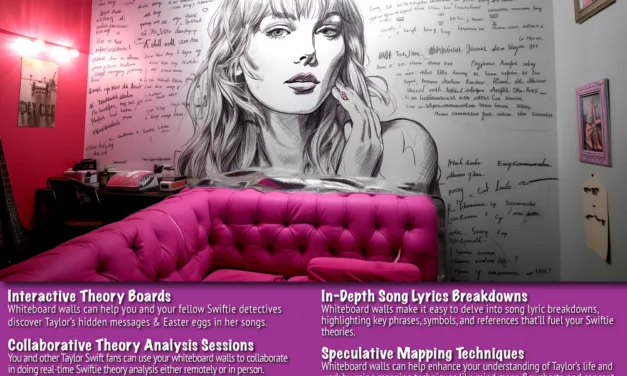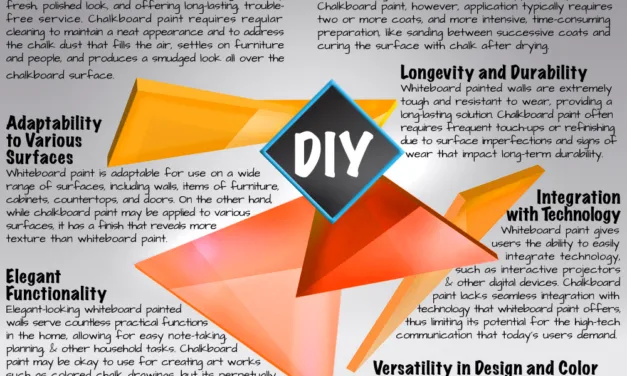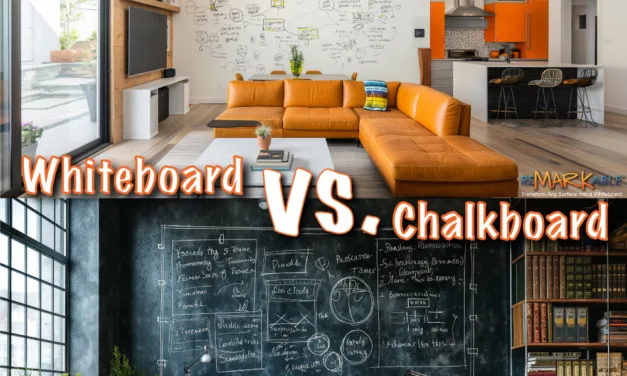Using a Dry Erase Wall to Keep Your Projects Organized
Why can a top-quality dry erase wall can be a manager’s best friend? Projects can be defined as distinct short-term efforts with definite beginnings and ends that are often limited by time constraints, finances, and staffing. The objective of projects is to create a product, service, or outcome intended to meet specific goals related to positive change or increased value. In practice, managing projects involves developing well-defined functional skills and organizational strategies. So when it comes to getting a project organized, a top-quality dry erase painted wall can, in fact, be a manager’s best friend.
In this article, several project management strategies using dry erase walls are presented to improve your efficiency and help ensure the success of your projects.
First, Eliminate Clutter on Your Dry Erase Wall to Avoid Distractions
Before starting to input information and ideas for initiating a new project, remove all of the old content on your dry erase wall that’s no longer pertinent or useful to the task at hand. A cluttered dry erase surface containing old ideas and information will need more room for fresh new thoughts and will also be distracting when you try to work efficiently on your latest project.
Disorganization and clutter of any type have a cumulative effect on the brain. Our brains are fond of order, so constant exposure to visual cues that trigger a sense of disorganization depletes our mental energy, thus reducing our ability to focus on work. Visually distracting clutter in the form of objects in a room or text on a surface, such as a dry erase wall, contributes to cognitive overload and may even diminish working memory. This effect can damage a team’s efficiency and productivity when trying to complete a project, so it’s essential to start your assignment with a clean, dry erase wall and a tidy work environment.
Designate Different Parts of the Whiteboard Wall for Different Topics
Designate one area of your dry erase wall for each major topic or line of thought related to your current project. Inscribe each main topic at the top of its designated wall area and only write about it in the assigned area to keep your team focused on one subject at a time. Numerous studies have shown that performing only one task at a time is a highly effective way to enhance individual and team productivity. While multitasking may seem stimulating and can even make you feel as if you’re being productive, it ends up making you less productive in the long run.
Use a Different Colored Dry Erase Marker to Correspond with Each Main Idea
Use a different colored low-odor dry erase marker for every topic connected with your project that’s posted on the board. Each set of ideas corresponding to a given topic should be written in its own color to make it easier to differentiate the various data types involved in your project. The main objective of color coding is to separate and organize. This goal is easily reached when you use a dry erase wall as your primary communication tool while initiating and completing a project.
Color Coding can also be used to Signify Current Project Status
The function of project status reports is to monitor prospects by pointing out areas that diverge from project baselines and stakeholders’ expectations. Therefore, status reports should be communicated in a way suited to the target audience’s knowledge and background. Standard types of status reports describe achievements related to the assigned tasks and also remark on work that’s behind schedule; problems that are being handled; major requests for changes in scope; recently recognized risks; and other points that will be useful for managers and stakeholders to know.
It’s common practice in the world of IT and project management to use color coding to distinguish the various parts of an undertaking based on separate categories. For instance, the colors of a stoplight are often used to report on the project’s current state. Here’s a way to use colors in your project status reports that make the pertinent information easy to understand:
• Green = good; the project is going well, is on course for timely completion within budget, and is under control.
• Red = currently off course. The project is in the ditch and will be unable to make its commitments in terms of cost, scope, or schedule. In order to get back on course, projects in this category need to have their budgets and schedules augmented or their scope of work expanded.
• Yellow = in potential jeopardy; all projects that don’t fit in the green or red category may be placed in this category. In such cases, projects are not entirely on track and under control but are not yet in the ditch either. In light of this definition of the green, red, and yellow categories, many projects in today’s business world could be placed in the yellow category.
Using the stoplight colors is a simple way to report to stakeholders, managers, and executives about the current state of your project without having to come up with many facts and figures.
Many businesses have found that color coding offers a practical means for conveying the appropriate amount of data about projects to management and stakeholders, and a dry erase wall is the perfect medium to carry out this process. After the color-coded information has been posted on your wall, you can take a picture of the finished product to send to your stakeholders, supervisors, and other management via email or text message. Otherwise, you can present your project status report utilizing a well-timed Zoom meeting with the relevant parties.
Create a Project Management Checklist to Stay on Track
A project management checklist can help project managers to remain motivated and on the right path to achieving their assigned objectives. Whether you’re starting a project from scratch or managing an ongoing effort, having a checklist will help you remain efficient in project execution and completion. In addition, if you have a project management checklist at hand, you’ll save time and money and be able to lessen the number of problems that come up during the project.
A checklist that’s used in the process of project management provides a yardstick for measuring the present direction of your efforts. In addition, it’s a tool that will show you what to do along the line as the project progresses and let you know if you’ve met the quality requirements for the project.
Defining and Using a Project Management Checklist On Your Dry Erase Wall
The term checklist refers to a detailed list of items or activities that are grouped together for several purposes. First, a checklist helps to ensure that all tasks that need to be completed in a given project are remembered and noticed. With all of the data in one convenient place, it’s easy to ensure all tasks are correctly handled and completed on time. Second, grouping tasks in this way makes comparative assessments easier.
It’s advisable to create a checklist at the very beginning of a project to ensure that all relevant tasks and activities are noted in one place throughout the project’s life. Then, as the project progresses, specific items may be checked or crossed off to show completion; also, depending on the degree of detail required, completion dates may be specified. In addition, checklists may be created for individually scheduled events within the project context, although these lists should operate in combination with the broader project checklist.
That being said, the ideal medium to use for creating your project checklist is a dry erase painted wall. There you can generate an extensive, easily viewed list of tasks that need to be done and adjoining boxes to check them off when they’re completed. Having the visual evidence of all the completed tasks checked off will remind you of the jobs that still need to be finished and help inspire you to continue until the project is successfully concluded.






























































































![ReMARKable’s Winter Sale is Here! [25% Off + Free Shipping]](https://www.remarkablecoating.com/wp-content/uploads/2018/01/Red-Tag-Winter-Fashion-Facebook-Post-1-440x264.png)















![Drive Your Organization Into Openness and Watch it Expand [20% Off Whiteboard Paint]](https://www.remarkablecoating.com/wp-content/uploads/2016/04/Drive-Your-Organization-Into-Openness-and-Watch-It-Expand.-1-440x264.jpg)

![30% Off St Patrick’s Day Sale! [Details Inside]](https://www.remarkablecoating.com/wp-content/uploads/2016/03/Glorious-1-440x264.png)


![Giant Leaps Forward Require Big Spaces. [Leap Year Sale Event!]](https://www.remarkablecoating.com/wp-content/uploads/2016/02/Giant-Leaps-ForwardRequire-Big-Spaces-440x264.jpg)

















![ReMARKable Summer Sale 2018 [28% Off Whiteboard Paint]](https://www.remarkablecoating.com/wp-content/uploads/2018/06/Blue-Simple-Line-Beach-Facebook-Post-1-440x264.png)






















































































































































































0 Comments